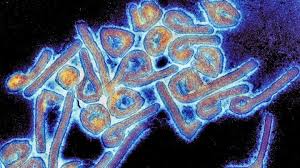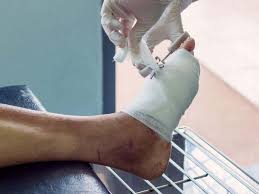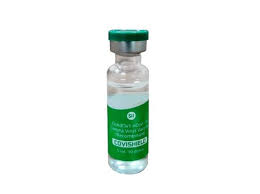Situation at a glance
Description of the situation
Since the previous Disease Outbreak News on this outbreak was published on 14 January 2025, two confirmed cases have been reported, and efforts are ongoing to ascertain the source of infection.
As of 10 February 2025, a cumulative of 10 cases have been reported including two confirmed and eight probable cases. All cases resulted in death, including eight who died before the confirmation of the outbreak. The two cases confirmed since the outbreak declaration died while in isolation at a designated MVD treatment centre. On 28 January, a safe and dignified burial was performed for the last confirmed case. No new confirmed or probable cases have been reported following this burial.
The presumptive index case, an adult female, had symptom onset on 9 December and died on 16 December 2024. All 10 cases were reported from Biharamulo district in Kagera region; the median age of cases was 30 years (range: 1 to 75 years) and the majority of cases (70%, 7) were females. Cumulatively, 90 suspected cases were reported between 20 January and 10 February, all of which tested negative for MVD.
As of 10 February 2025, all 281 contacts that were listed have completed 21 days of follow-up.
The first MVD outbreak in Tanzania was reported in March 2023 in Bukoba district in Kagera region, and zoonotic reservoirs, such as fruit bats, remain endemic to the area. The outbreak in March 2023 lasted for nearly two months with nine cases including six deaths.
Figure 1: Map of district reporting Marburg virus disease confirmed and probable cases in the United Republic of Tanzania, as of 10 February 2025
Epidemiology
MVD is a highly virulent disease that can cause severe disease and is clinically similar to Ebola disease (EBOD). EBOD and MVD are caused by orthoebolaviruses and orthomarburgviruses respectively; both are members of the Filoviridae family (filovirus). People become infected after prolonged exposure to mines or caves inhabited by Rousettus fruit bat colonies, a type of fruit bat, that can carry the Marburg virus. Marburg virus then spreads between people via direct contact (through broken skin or mucous membranes) with the blood, secretions, organs or other bodily fluids of infected people, and with surfaces and materials (e.g. bedding, clothing) contaminated with these fluids. Health workers have previously been infected while treating patients with suspected or confirmed MVD. Burial ceremonies that involve direct contact with the body of the deceased can also contribute to the transmission of Marburg virus.
The incubation period varies from two to 21 days. Illness caused by Marburg virus begins abruptly, with high fever, severe headache and severe malaise. Severe watery diarrhoea, abdominal pain and cramping, nausea and vomiting can begin on the third day. Although not all cases present with haemorrhagic signs, severe haemorrhagic manifestations may appear between five and seven days from symptoms onset, and fatal cases usually have some form of bleeding, often from multiple areas of the body. In fatal cases, death occurs most often between eight and nine days after symptom onset, usually preceded by severe blood loss and shock. There is currently no approved treatment or vaccine for MVD. Some candidate vaccines and therapeutics are currently under investigation.
Eighteen outbreaks of MVD have previously been reported globally. The most recent outbreak was reported from Rwanda between September and December 2024. Additional countries that previously reported outbreaks of MVD in the African Region include Angola, the Democratic Republic of the Congo, Equatorial Guinea, Ghana, Guinea, Kenya, South Africa, the United Republic of Tanzania and Uganda.
Public health response
- The Ministry of Health developed a national response plan to guide response activities.
- A National Incident Management System was activated to coordinate the response to the event and a national task force was activated, and meetings are held weekly. At the sub-national level, regular coordination meetings are being held in Kagera Region.
- A national rapid response team was deployed to the affected region to enhance outbreak investigation and response, with technical and operational support from WHO and health partners.
- WHO has deployed experts to support the MoH with partner coordination and other response activities in different pillars.
- Surveillance activities continue with active case finding and contact tracing across affected areas.
- The mobile laboratory deployed in Kabaile continues to support the testing of suspect cases for rapid turnaround time, and samples are referred to the central public health laboratory in Dar es Salaam for additional tests. Additionally, genomic sequencing was conducted on the two positive samples.
- Screening of travellers departing from Kagera Region continues at key points of entry and exit, including Bukoba airport.
- Healthcare worker sensitization sessions on infection prevention and control are ongoing across Kagera and other regions.
- The Marburg Treatment Unit has been upgraded with enhanced triage, patient wards, and donning and doffing areas. Public awareness campaigns, including health education, door-to-door outreach by community health workers, and public announcements in high-risk areas, are ongoing.
- Cross border meetings have been convened between Tanzania, Uganda and Burundi.
- WHO has procured and delivered four VHF kits to Kagera region to support the response.
WHO risk assessment
The risk of this MVD outbreak is assessed as high at the national level due to several concerning factors. The outbreak thus far involves 10 cases (eight probable and two confirmed), including 10 deaths, resulting in a CFR of 100%. One case was a healthcare worker, highlighting the risk of nosocomial transmission. The source of the outbreak is still unknown. The delayed detection and isolation of cases could lead to a missed chain of transmission.
The regional risk is considered high due to Kagera’s strategic location as a transit hub, with significant cross-border movement of the population to Rwanda, Uganda, Burundi and the Democratic Republic of the Congo. This highlights the potential for spread into neighbouring countries. MVD is not easily transmissible (i.e. in most instances, it requires contact with the body fluids of a sick patient presenting with symptoms or with surfaces contaminated with these fluids). However, it cannot be excluded that a person exposed to the virus may travel.
The global risk is currently assessed as low. There is no confirmed international spread at this stage, although there are concerns about potential risks. Kagera region of Tanzania, while not close to the country’s capital or major international airports, is well-connected through transportation networks, and has an airport that connects to Dar es Salaam for onward travel outside Tanzania by air. This highlights the need for enhanced surveillance and case management capacities at relevant points of entry and along borders, as well as close coordination with neighbouring countries to strengthen readiness capacities.
WHO advice
Human-to-human transmission of Marburg virus is primarily associated with direct contact with the blood and/or other bodily fluids of infected people. WHO advises the following risk reduction measures be taken as an effective way to reduce MVD transmission and control an outbreak.
Prevention: Protective measures individuals should take to reduce human exposure to the virus include:
- Close physical contact with MVD patients should be avoided to reduce the risk of human-to-human transmission in the community arising from direct or close contact with infected patients, particularly with their body fluids.
- People suspected or confirmed for MVD should immediately seek care in health facilities and be isolated in a designated treatment centre for early care and to avoid transmission at home.
- Community and family members should avoid caring for symptomatic individuals at home and avoid touching the bodies of people deceased with MVD symptoms. They should avoid touching other potentially contaminated items and surfaces. They should be encouraged to go to a health facility for assessment and treatment if they have symptoms.
- During work or research activities or tourist visits in mines or caves inhabited by fruit bat colonies, people should wear gloves and other appropriate protective clothing (including masks) to reduce the risk of bat-to-human transmission arising from prolonged exposure to mines or caves inhabited by fruit bat colonies. Additionally, during outbreaks, all animal products (blood and meat) should be thoroughly cooked before consumption.
Coordination: Multisectoral coordination, pillar meetings and sharing of detailed situation reports is encouraged at all levels involved in the response. The involvement of different stakeholders and partners in preparedness and response activities is also encouraged. To ensure an effective and sustained response, resource mobilization efforts within the government and with partners are recommended.
Risk communication and community engagement: Raising public awareness and engaging with communities are important for successfully controlling MVD outbreaks. This includes raising awareness of symptoms, risk factors for infection, protective measures and the importance of seeking immediate care at a health facility. This awareness should be increased through targeted campaigns and direct work with communities. Special attention should be given to high-risk groups, such as traditional healers, clergy, and community leaders, who may inadvertently facilitate disease spread, and who are important sources of information for the community.
Recommendations for responders involved in RCCE for MVD, are available in WHO’s risk communication and community engagement for Marburg virus disease outbreaks; in summary:
- Allocate sufficient resources to RCCE so at-risk communities are ready to respond to outbreaks.
- Collect, analyse and use social and behavioural data and evidence to guide MVD readiness and response measures.
- Rapidly communicate risks relating to MVD through multiple channels; share tailored messages that raise awareness, encourage seeking healthcare, and explain uncertainty.
- Address infodemics through integrated community feedback mechanisms; counter misinformation and rumours with accurate health information to foster trust and promote early symptom reporting.
- Understand, prevent and address MVD stigma and discrimination.
- Involve communities in planning and implementing MVD readiness and response measures, with a particular focus on providing sensitive and supportive information about safe and dignified burial practices for those who have died from MVD symptoms.
Surveillance: Active case detection, contact tracing, and alert management across affected and neighbouring regions should be intensified. Community-based surveillance systems should be strengthened to promptly identify and report new cases, particularly in high-risk areas. Close monitoring of healthcare workers, family members and individuals who have had contact with suspected cases or other high-exposure settings should be ensured. Surveillance capacities should also be intensified at relevant points of entry and along borders to reduce the risk of further spread, including internationally.
Infection prevention and control (IPC) measures: Critical infection prevention and control measures should be implemented and/or strengthened in all health care facilities, per WHO’s Infection prevention and control guideline for Ebola and Marburg disease, which highlights the importance of the rapid implementation of the IPC ring approach including but not limited to IPC rapid assessment, decontamination of the health facilities and household and early detection and identification of the cases through the screening and isolation of the suspected cases to minimize the transmission risk.
- Health workers caring for patients with confirmed or suspected MVD should apply transmission-based precautions in addition to standard precautions including appropriate use of personal protective equipment (PPE) and hand hygiene according to the WHO 5 moments to avoid contact with patient’s blood and other body fluids and with contaminated surfaces and objects. Waste generated in healthcare facilities must be safely segregated, safely collected, transported, stored, treated and finally disposed. Follow the national guidelines, rules and regulations for safe waste disposal or follow the WHO’s guidelines on safe waste management
- Patient-care activities should be undertaken in a clean and hygienic environment that facilitates practices related to the prevention and control of health-care-associated infections (HAIs) as outlined in Essential environmental health standards in health care. Safe water, adequate sanitation and hygiene infrastructure and services should be provided in healthcare facilities. For details on recommendations and improvement, follow the WASH FIT implementation Package
Laboratory testing: The processing and analysis of samples should be expedited, with results promptly shared with responders and clinicians to guide patient management, containment strategies and broader response efforts. This includes the sequences resulting from the genomic sequencing of positive samples. International referral of samples to a regional reference laboratory should be considered for inter-laboratory comparison. Diagnostic testing for Ebola and Marburg virus diseases: interim guidance
Evaluation of candidate medical countermeasures: There are no licensed vaccines or therapeutics against MVD. Several candidate vaccines are in the pipeline and outbreaks offer an opportunity to assess their efficacy and safety. There are protocols available and a network of experts in filovirus ready to support national researchers.
Safe and dignified burials: Safe and dignified burial protocols should be implemented for people who have died to minimize community exposure. Additional training and equipment for healthcare workers and burial teams should be provided to ensure safe management of MVD-related fatalities. Thorough community engagement is required to ensure that affected communities are empowered to adhere to the protocol. How to conduct safe and dignified burial of a patient who has died from suspected or confirmed Marburg virus disease.
Case management and psychosocial support: Isolation and treatment facilities should be adequately equipped to ensure the safety and efficacy of patient care, while simultaneously preventing the spread of the disease. Supportive care such as rehydration, symptom management, and psychological support for patients and their families is essential to improving survival rates and mitigating the outbreak’s impact.
Border health and cross-border coordination: Surveillance and response capacities should be strengthened at relevant points of entry, onboard conveyances, and in border regions to prevent further spread, including internationally. Cases, contacts and individuals in affected areas who present signs and symptoms compatible with case definitions should be advised not to travel in line with WHO’s border health and points of entry technical guidance for filovirus disease outbreaks. Collaboration with neighbouring countries should be enhanced to harmonize reporting mechanisms, conduct joint investigations, and share critical data in real-time. Surrounding countries should enhance readiness activities to enable early case detection, isolation and treatment. Considerations for border health and points of entry for filovirus disease outbreaks
Preparedness and Readiness: Readiness assessments in high-risk regions should be conducted to ensure adequate response mechanisms, such as laboratories and isolation units, are adequately equipped for early detection and management of new cases.
Travel and Trade: Based on the current risk assessment, WHO advises against any travel and against any trade restrictions with the United Republic of Tanzania.
Further information
- WHO Director-General’s opening remarks at the media briefing on outbreak of Marburg virus disease https://www.who.int/news-room/speeches/item/who-director-general-s-opening-remarks-at-the-media-briefing-on-outbreak-of-marburg-virus-disease—20-january-2025
- The United Republic of Tanzania confirms outbreak of Marburg virus disease https://www.afro.who.int/countries/united-republic-of-tanzania/news/tanzania-confirms-outbreak-marburg-virus-disease
- WHO Factsheet- Marburg virus disease https://www.who.int/news-room/fact-sheets/detail/marburg-virus-disease
- Infection prevention and control guidelines for Ebola and Marburg disease, August 2023. https://www.who.int/publications/i/item/WHO-WPE-CRS-HCR-2023.1
- WHO Questions and Answers – Marburg virus disease.https://www.who.int/news-room/questions-and-answers/item/marburg-virus-disease Risk communication and community engagement for Marburg virus disease outbreaks. Interim Guidance November 2024. https://iris.who.int/bitstream/handle/10665/379761/B09185-eng.pdf?sequence=1
- Steps to putting on PPE for Ebola/Marburg coverall. https://www.who.int/multi-media/details/steps-to-put-on-ppe-for-ebola-marburg-disease-coverall
- Steps to removing PPE for Ebola/Marburg disease coverall. https://www.who.int/multi-media/details/steps-to-remove-ppe-for-ebola-marburg-disease-coverall
- Steps to putting on PPE for Ebola/Marburg gown and headcover. https://www.who.int/multi-media/details/steps-to-put-on-ppe-for-ebola-marburg-disease-gown-and-headcover
- Steps to removing PPE for Ebola/Marburg gown and headcover. https://www.who.int/multi-media/details/steps-to-remove-ppe-for-ebola-marburg-disease-gown-and-headcover
- Standard precautions for the prevention and control of infections: aide-memoire. https://www.who.int/publications/i/item/WHO-UHL-IHS-IPC-2022.1
- Transmission-based precautions for the prevention and control of infections: aide-memoire. https://www.who.int/publications/i/item/WHO-UHL-IHS-IPC-2022.2
- Essential environmental health standards in healthcare facilities- https://www.who.int/publications/i/item/9789241547239
- WASH FIT implementation for WASH improvements in healthcare facilities WASH FIT Fact Sheets | WASH in Health Care Facilities (washinhcf.org) https://www.washinhcf.org/wash-fit-fact-sheets/
- World Health Organization (March 2009). Hand hygiene technical reference manual: to be used by health-care workers, trainers and observers of hand hygiene practices. https://www.who.int/publications/i/item/9789241598606
- Ebola and Marburg diseases screening and treatment center design training. https://openwho.org/courses/ebola-marburg-screen-treat-facilities
- World Health Organization (2 June 2023). Disease Outbreak News; Marburg virus disease in the United Republic of Tanzania. https://www.who.int/emergencies/disease-outbreak-news/item/2023-DON471
- Markotter W, Coertse J, DeVries M, et al. Bat-borne viruses in Africa: a critical review. J of Zoology. 2020;311:77-98. doi:10.1111/jzo.12769. https://zslpublications.onlinelibrary.wiley.com/doi/10.1111/jzo.12769(link is external)
- Korine C Rousettus aegyptiacus. The IUCN Red List of Threatened Species 2016: e.T29730A22043105. https://www.iucnredlist.org/species/29730/22043105
- Cross RW, Longini IM, Becker S, Bok K, Boucher D, Carroll MW, et al. (2022) An introduction to the Marburg virus vaccine consortium, MARVAC. PLoS Pathog 18(10): e1010805. https://doi.org/10.1371/journal.ppat.1010805
- A WHO-Strategic Research Agenda for Filovirus Research and Monitoring (WHO-AFIRM). https://www.who.int/publications/m/item/a-who-strategic-research-agenda-for-filovirus-research-and-monitoring—–(who-afirm)
- Building research readiness for a future filovirus outbreak, Workshop February 20 – 22, 2024, Uganda https://www.who.int/news-room/events/detail/2024/02/20/default-calendar/building-research-readiness-for-a-future-filovirus-outbreak-workshop-february-20-22-2024-uganda
- WHO Technical Advisory Group – candidate vaccine prioritization. Summary of the evaluations and recommendations on the four Marburg vaccines. https://www.who.int/publications/m/item/who-technical-advisory-group—candidate-vaccine-prioritization.–summary-of-the-evaluations-and-recommendations-on-the-four-marburg-vaccines
- Marburg virus vaccine landscape https://www.who.int/publications/m/item/marburg-virus-vaccine-landscape
- Marburgvirus therapeutics landscape https://www.who.int/publications/m/item/marburg-virus-therapeutics-landscape
- Considerations for border health and points of entry for filovirus disease outbreaks: https://www.who.int/publications/m/item/considerations-for-border-health-and-points-of-entry-for-filovirus-disease-outbreaks
Citable reference: World Health Organization (14 February 2025). Disease Outbreak News; Marburg virus disease in the United Republic of Tanzania. Available at: https://www.who.int/emergencies/disease-outbreak-news/item/2025-DON554













